Help to Buy...only those who can afford high prices

The Government's Housing for All Strategy committed to considering an extension to the Help to Buy Scheme for first time buyers, due to expire in 31 December 2021, and to reviewing it to ensure that it is "apppropriately calibrated".
Social Justice Ireland has advocated against Help to Buy since it was introduced in Budget 2017 as we believed then that it would artificially maintain high house prices. Our latest analysis shows that not only has Help to Buy disproportionately benefitted purchasers buying higher value properties since its introduction, but that this support is contributing to the affordability crisis.
From its introduction in October 2016 to the end July 2021, a total of 26,744 claims have been made under the scheme, totalling €470 million[1]. Analysing full year data to end-2020, over one third of claims (34.47 per cent) were in respect of properties worth between €301,000 and €375,000, and a further three in ten (31.86 per cent) were for properties worth between €226,000 and €300,000. The proportion of claims at the highest end of the market, those in respect of properties worth over €450,000 was more than three times that of cheaper homes, those worth €150,000 or less, which accounted for less than 2 per cent of all claims (Chart 1).
Chart 1: Proportion of Help to Buy Scheme Claims by Property Value Range, to end-2020
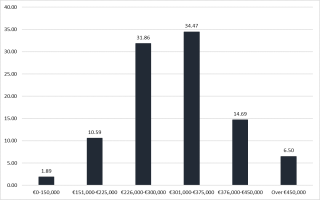
Source: Revenue Commissioners, Help To Buy (HTB) Statistics 2020
However, it is when we compare the proportion of claims in each property value range with the purchases registered on the property price register (PPR) that the extent of the Scheme's distortionary impact on the housing market becomes apparent.
Charts 2 to 5 show the proportion of Help to Buy claims and purchases registered with on PPR for the full period in which the Help to Buy Scheme has been operational. This includes retrospective claims (and purchases) from the 19th July 2016 (these purchases are included in Chart 5 “To end-2017” data). To provide as comprehensive a comparative analysis as possible, and as the Help to Buy Scheme is available in respect of new homes only, we have included both all purchases registered on the PPR and purchases of newly constructed homes only.
These data show that not only has Help to Buy disproportionately benefitted purchasers buying higher value properties since its introduction, but that this support is contributing to the affordability crisis.
Chart 2: Proportion of Help to Buy Scheme Claims and Property Purchase Registrations by Property Value Range, 2020
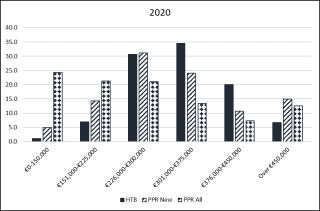
Source: Revenue Commissioners, Help To Buy (HTB) Statistics 2020 and Property Services Regulatory Authority, Residential Property Price Register
Last year, a total of 6,202 claims were made under the Help to Buy Scheme. Of these, one in five were in value range €376,000 to €450,000; over one third (34.4 per cent) were in the value range €301,000 to €375,000; and more than three in ten (30.7 per cent) were in the value range €226,000 to €300,000. This compares to 10.7 per cent; 24.0 per cent; and 31.1 per cent respectively of new homes registered on the PPR; and 7.3 per cent; 13.4 per cent; and 21.1 per cent respectively of all home Purchases registered on the PPR that year.
The proportion of purchases subsidised by the Help to Buy Scheme in the value range €376,000 to €450,000 was almost twice that of new home purchases registered on the PPR and almost three times that of all purchases registered that year.
A little over 1 per cent of all purchases subsidised by the Help to Buy Scheme were in the lowest value range of €0 to €150,000, compared to 5 per cent of new home purchases registered on the PPR and 24.3 per cent of purchases registered that year.
Chart 3: Proportion of Help to Buy Scheme Claims and Property Purchase Registrations by Property Value Range, 2019
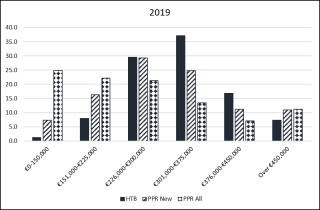
Source: Revenue Commissioners, Help To Buy (HTB) Statistics 2020 and Property Services Regulatory Authority, Residential Property Price Register
The previous year, in 2019, one in seven were in value range €376,000 to €450,000; almost two in five (37.2 per cent) were in the value range €301,000 to €375,000; and almost three in ten (29.5 per cent) were in the value range €226,000 to €300,000. This compares to 11.2 per cent; 24.8 per cent; and 29.3 per cent respectively of new homes registered on the PPR; and 7.1 per cent; 13.4 per cent; and 21.3 per cent respectively of all home Purchases registered on the PPR that year.
The proportion of purchases subsidised by the Help to Buy Scheme in the value range €376,000 to €450,000 was one and a half times that of new home purchases registered on the PPR and more than twice that of all purchases registered that year.
As with 2020, a little over 1 per cent of all purchases subsidised by the Help to Buy Scheme were in the lowest value range of €0 to €150,000, compared to 7.3 per cent of new home purchases registered on the PPR and 24.8 per cent of purchases registered that year.
Chart 4: Proportion of Help to Buy Scheme Claims and Property Purchase Registrations by Property Value Range, 2018
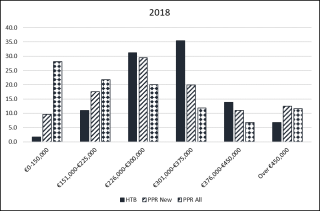
Source: Revenue Commissioners, Help To Buy (HTB) Statistics 2020 and Property Services Regulatory Authority, Residential Property Price Register
A similar pattern emerged in 2018, with 13.8 per cent of purchases subsidised by the Help to Buy scheme in the value range €376,000 to €450,000; more than a third (35.5 per cent) were in the value range €301,000 to €375,000; and more than three in ten (31.2 per cent) were in the value range €226,000 to €300,000. This compares to 11 per cent; 19.9 per cent; and 29.5 per cent respectively of new homes registered on the PPR; and 6.7 per cent; 11.9 per cent; and 20 per cent respectively of all home Purchases registered on the PPR that year.
The proportion of purchases subsidised by the Help to Buy Scheme in the value range €376,000 to €450,000 was almost three percentage points of new home purchases registered on the PPR and twice that of all purchases registered that year.
A little under 2 per cent of all purchases subsidised by the Help to Buy Scheme were in the lowest value range of €0 to €150,000, compared to 9.6 per cent of new home purchases registered on the PPR and 28.1 per cent of purchases registered that year.
Chart 5: Proportion of Help to Buy Scheme Claims and Property Purchase Registrations by Property Value Range, up to 2017
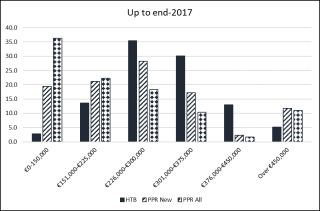
Source: Revenue Commissioners, Help To Buy (HTB) Statistics 2020 and Property Services Regulatory Authority, Residential Property Price Register
Note: PPR Purchases dates range from 16th July 2016 to 31st December 2017
And finally, the first year in which the Scheme existed. Up to the end of 2017, 12.9 per cent of purchases subsidised by the Help to Buy scheme were in the value range €376,000 to €450,000; more three in ten (30.1 per cent) were in the value range €301,000 to €375,000; and more than a third (35.4 per cent) were in the value range €226,000 to €300,000. This compares to 2.3 per cent; 17.2 per cent; and 28.2 per cent respectively of new homes registered on the PPR; and 1.7 per cent; 10.4 per cent; and 18.3 per cent respectively of all home Purchases registered on the PPR that year.
The proportion of purchases subsidised by the Help to Buy Scheme in the value range €376,000 to €450,000 was more than five and a half times that of new home purchases registered on the PPR and seven and a half times that of all purchases registered that year.
Almost 3 per cent of all purchases subsidised by the Help to Buy Scheme were in the lowest value range of €0 to €150,000, compared to 19.4 per cent of new home purchases registered on the PPR and 36.2 per cent of purchases registered that year.
Affordability Gap
The data in Charts 2 to 5 indicate that, not only is the Help to Buy Scheme benefitting purchasers of higher-value homes, it is driving purchasers towards these homes by artificially increasing their purchasing capacity. The proportion of homes with a value in the lowest range subsidised by the Help to Buy Scheme has reduced by almost two thirds since it was introduced. This is contributing to the affordability gap in the housing market.
Higher Prices, Higher Incomes
In 2020, almost two-thirds (61.2 per cent) of purchases subsidised by the Help to Buy Scheme were in respect of properties valued at €301,000 or more. Assuming a 10 per cent deposit (required for first time buyers under the Central Bank’s macroprudential rules) the household income required to get a mortgage for a property worth €301,000 is over €77,000, while the income required to get a mortgage for a property worth €376,000 is almost €96,500 (see Table 1).
Table 1: Property Value Ranges, Deposit Required, Mortgage Required and Household Income Required*
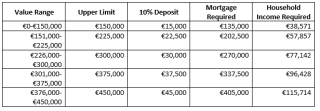
Note: *Based on a household with a 10 per cent deposit obtaining a mortgage of 3.5 times their salary.
These incomes are beyond most households and demonstrate, again, that the Help to Buy Scheme is a subsidy for the better off.
Tax Strategy Group Review
The Tax Strategy Group established by the Department of Finance has conducted a review of the Help to Buy Scheme in its paper 'TSG 21 - 02 Income Tax (Incorporating a Review of the Help-to-Buy Scheme)'. The Group estimates that Help to Buy will cost the Exchequer €170 million in 2021 in its enhanced form, including the increase made last year. The Review sets out five options for the future of the HTB Scheme:
- Option 1: Allow the scheme expire on 31 December 2021
- Option 2: Extend the scheme for a further two years in its current “enhanced” form
- Option 3: Extend the scheme for a further two years in its original (pre-July 2020) form
- Option 4: Extend the scheme but phase out over a number of years by tapering the amount of tax relief available
- Option 5: The question of expanding the scheme to include derelict properties
Social Justice Ireland is of the view that this scheme should be allowed to expire on the 31st December this year. It is regressive; expensive; and is artificially maintaining high house prices for newly constructed homes. If Government really want to provide Homes for All, they need to address supply-side issues and make house prices truly affordable.
To read Social Justice Ireland's Pre-Budget Submission - CLICK HERE
To read Social Justice Ireland's Review of the Housing for All Strategy - CLICK HERE
[1] Department of Finance, Tax Strategy Group, TSG 21 - 02 Income Tax (Incorporating a Review of the Help-to-Buy Scheme